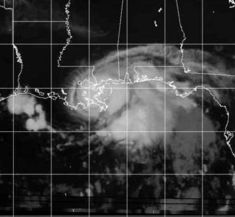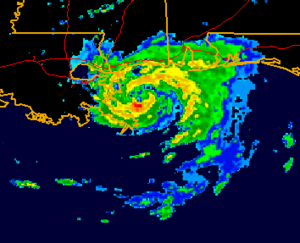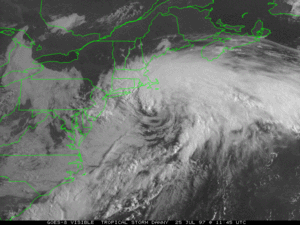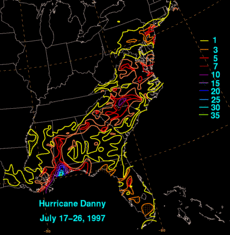Hurricane Danny (1997)
2007 Schools Wikipedia Selection. Related subjects: Natural Disasters
| Category 1 hurricane ( SSHS) | ||
|---|---|---|
|
Hurricane Danny over southeast Louisiana |
||
| Formed | July 16, 1997 | |
| Dissipated | July 27, 1997 | |
| Highest winds |
|
|
| Lowest pressure | 984 mbar ( hPa) | |
| Damage | $100 million (1997 USD) $120 million (2005 USD) |
|
| Fatalities | 4 direct, 6 indirect | |
| Areas affected |
Louisiana, Alabama, Georgia, Virginia, Massachusetts | |
| Part of the 1997 Atlantic hurricane season |
||
Hurricane Danny was the only hurricane to make landfall in the United States during the 1997 Atlantic hurricane season. Danny is most noted for the extreme rainfall it produced on its path, causing four direct fatalities and $100 million (1997 USD, $120 million 2005 USD) in damage. Danny brought about the end of a busy early start of the season, and became the earliest 5th tropical or subtropical storm of a season when it reached tropical storm strength on July 17. This record was broken in 2005 when Tropical Storm Emily attained tropical storm status on July 12. Another unusual fact of Danny was its extended northeast track through the Gulf of Mexico, a rare occurrence in the middle of July due to two high pressure systems.
Storm history
Like the previous four tropical or subtropical cyclones of the season, Danny's origin was non-tropical. A broad mid-tropospheric trough over the southeastern United States spawned an area of convection over the lower Mississippi River Valley in mid-July, and drifted southward towards the warm waters of the Gulf of Mexico. Deep convection became organized near a cyclonic circulation, and the system was declared Tropical Depression Four on July 16 while about 150 miles (240 km) south of the Louisiana coastline. The depression slowly organized as it drifted to the northeast, and strengthened into Tropical Storm Danny on July 17.
Throughout the night of the 17th and throughout the 18th, Danny quickly developed deep convection and banding features in the favorable environment of the Gulf of Mexico, and reached hurricane status later on the 18th. Stuck between two high pressure systems, Danny continued its unusual July track to the northeast, and crossed over southeastern Louisiana near the Mississippi River Delta. A small storm, Danny continued to strengthen after again reaching the Gulf of Mexico on the night of the 18th, and attained a peak of 80 mph (130 km/h) early on the 19th.
After stalling near the mouth of Mobile Bay on July 19, Hurricane Danny turned to the east, and made its final landfall near Mullet Point, Alabama later that day. The storm rapidly weakened as it continued northward, and was only a tropical depression by the 20th. The weak depression moved through Alabama, Georgia, South Carolina, and North Carolina, maintaining a well-defined cloud signature. Due to a front behind the system, Danny strengthened baroclinically over North Carolina to a tropical storm on the 24th. It quickly reached a secondary peak of 60 mph (96 km/h), and continued rapidly northeastward. A strong mid to upper-level cyclone brought Danny northward, threatening Massachusetts. It stalled while just 30 miles (48 km) southeast of Nantucket on July 26, turned to the east out to sea, and became extratropical later that day. On July 27, the former hurricane merged with a frontal zone.
Impact
Because Danny was a small storm, it caused a damage toll of only $100 million (1997 USD, $120 million 2005 USD), likely a lower amount than if a larger storm were to repeat it. It caused a total of 4 direct deaths and 6 indirect deaths.
Gulf Coast
Like other slow-moving tropical cyclones, Danny produced extreme amounts of rainfall over Louisiana and Alabama. The highest amount was 36.71 inches (932 mm), located at Dauphin Island. But the rainfall may have been underestimated, as not all the rain was caught in the rain gauge. Doppler radar estimates show that around 43 inches (1,090 mm) of rain fell off the coast of Dauphin Island. Much of the extreme rainfall was confined to a small radius near the centre of the small storm, and limited the flooding, which could have been disastrous if it were widespread.
In addition to the rainfall, Danny caused storm surge of over 6.5 foot (1.98 m) off of Highway 182, midway between Gulf Shores, and Fort Morgan, Alabama, though the surge caused relatively little impact. Unusually, when Danny stalled off the coast of Alabama, prevailing northerly winds forced the water out of Mobile Bay, causing tides to be two feet (0.61 m) below normal. Observers noted that, with the exception of river channels, it would be possible to walk across the bay. Despite its effects in the northern Gulf of Mexico, only one person was directly killed from the storm here: a man drowning off the coast when he fell off his sailboat near Fort Morgan. One indirect casualty occurred in the area, when a man had a heart attack while trying to secure a boat off the Alabaman coast during the storm. In addition, two tornadoes occurred in Alabama. One was in Orange Beach, while the other one occurred in Port Alabama.
East Coast
Though Danny's impact was severely reduced when it reached Georgia and the Carolinas, it still managed to cause 8-12 inches (203.2-304.8 mm) of rain as it drifted through the western portions of the states. A severe thunderstorm cell in South Carolina produced five tornadoes that touched down, one of which killed a woman in her destroyed duplex while passing through Lexington County. The heavy rains caused two people to drown in Charlotte. One of the people who drowned was a girl who was swept into a creek by the floodwaters. The other one was a woman who drowned from the floodwaters while in her car. Four indirect deaths occurred from traffic accidents during the storm's onslaught in Georgia.
Danny also spawned several tornadoes and waterspouts over Virginia; most of them occurred in Norfolk, Portsmouth, and Hampton. The tornado in Portsmouth wiped out a car wash, caused six other businesses to suffer lesser damage (including a lumber company that had its roof torn off,), and one large truck big-rig wheeler was overturned. Elsewhere in the Mid-Atlantic States, a severe drought was in place during the month of July. Copious rainfall amounts helped bring a minor relief to the drought. Strong winds were experienced in southeastern Massachusetts, though damage was minor. Rainfall on Martha's Vineyard measured 2.88 inches (73.1 mm) of rain, while most of southern New England received approximately 3 inches (76.1 mm) of rain.
Lack of retirement
The name Danny was not retired by the World Meteorological Organization in the spring of 1998 and it was re-used in the 2003 Atlantic hurricane season. It is currently on the list of names to be used again in the 2009 Atlantic hurricane season.
Records
Danny dropped 36.71 inches (932 mm) on Dauphin Island, setting the new record for the most tropical or subtropical cyclone related rainfall in the state of Alabama, and is among the largest in the United States. The storm also became the earliest 5th tropical or subtropical storm of a season when it reached tropical storm strength on July 17. This record was broken in the 2005 Atlantic hurricane season when Hurricane Emily first attained tropical storm status on July 12, just five days earlier.




